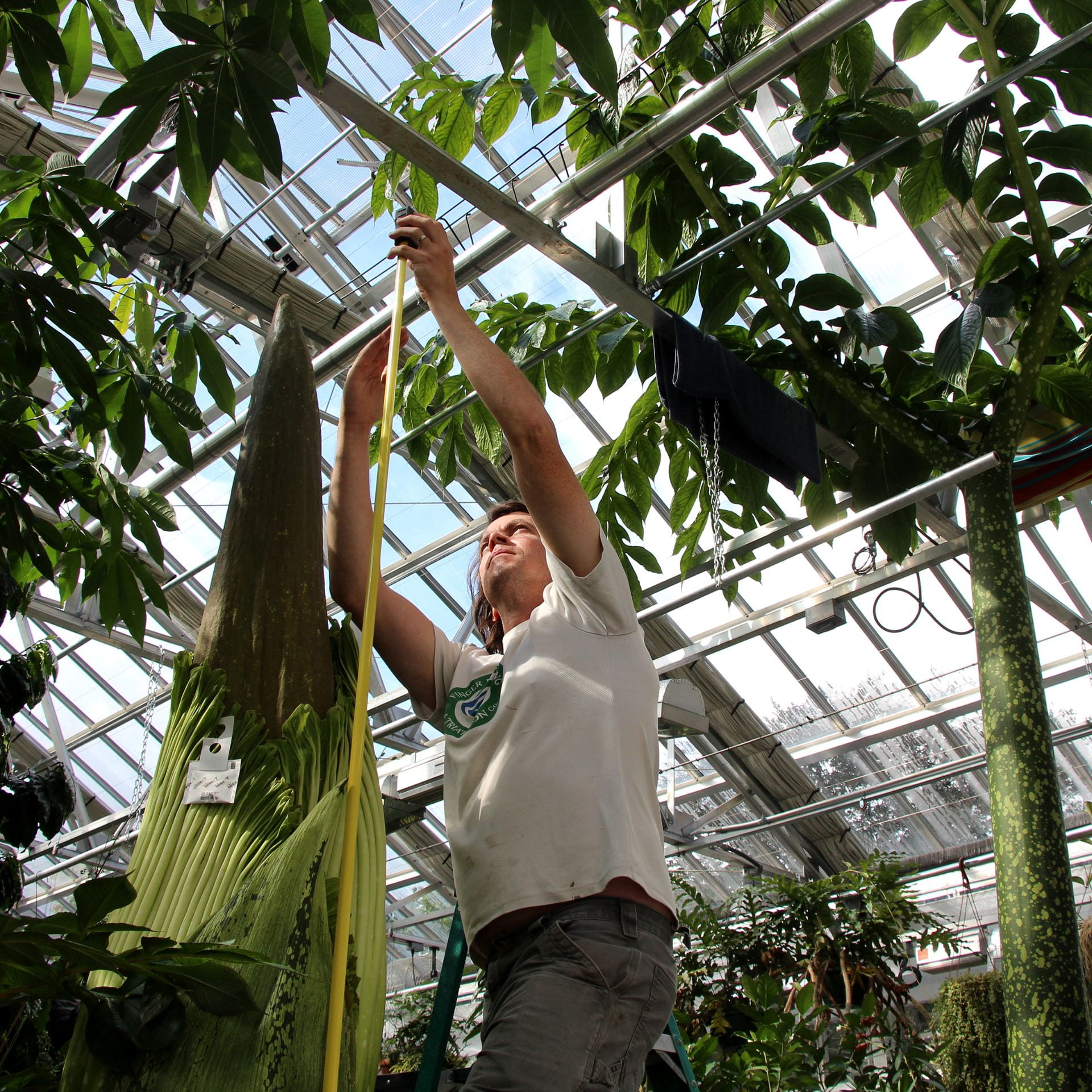Carolus – one of a pair of Cornell Titan arums – will again unleash its fetid odor in the Liberty Hyde Bailey Conservatory on Tower Road in the coming days.
“The flowering is brief – just a day or two – and difficult to predict,” says Paul Cooper, the Cornell University Agricultural Experiment Station (Cornell AES) greenhouse grower who cares for the Titan arums and more than 600 other species of plants in the Conservatory. “But the bloom is nothing if not memorable.”
That’s because the Titan arum (Amorphophallus titanum) – native to the jungles of Sumatra where it is threatened by habitat loss – has a fascinating pollination strategy: It releases volatile chemicals that smell like a rotting carcass to attract flies and carrion beetles to transport pollen from one plant to another.
The plant also warms to over 100 degrees F to help waft the foul scent up into the canopy so it can travel far and wide. Skunk cabbage – a related plant native to the Finger Lakes – uses a similar strategy when it flowers in early spring, often melting surrounding snow.
Titan arums also produce the largest unbranched inflorescence (flowering structure) in the plant world, towering as high as 3 meters. The last time Carolus flowered, it reached 75 inches tall. As of September 8, it already stood 72 inches and was growing about 5 inches a day. (View growth chart.)

This will be only the second time since 2012 – when Carolus’s sibling Wee Stinky was the first Titan arum to flower at Cornell – that the plants have bloomed while students are on campus. “They’ve been pretty bashful. This is the seventh bloom we’ve had but it seems like they’re always flowering during breaks,” says Cooper. “We hope the students will take advantage of this opportunity to come to the Conservatory to experience it firsthand.”
Titan arum flowerings were relatively rare at the time of that first flowering, which attracted more than 10,000 visitors who stood in line for an hour or more to catch a glimpse – and get a whiff. But since then, the species has become popular in conservatories around the world.
During that first flowering, Wee Stinky was pollinated by hand with pollen provided by Binghamton University, and Cooper distributed dozens of the resulting seeds and seedlings. The plants usually take seven to ten years to reach flowering size.
Between flowerings, Titan arums produce a single towering leaf the size of a small tree. While Carolus blooms this month, Wee Stinky is in full leaf alongside it. The leaf gathers energy from the sun to refuel the corm – an underground bulb-like structure – to power the next flowering. Carolus’s corm weighed about 120 pounds when Cooper re-potted it in July.
Since they reached maturity, Cooper has been able to coax each plant to bloom about every two years or so. The last time Carolus flowered, its timing was perfect and Cooper planted the corm outside in a pot in nearby Minns Garden. That was perhaps the farthest north a Titan arum has bloomed unprotected from the elements.
In the run-up to the flowering, the Conservatory is open to the public weekdays from 10 a.m. to 3 p.m. Late one afternoon in the near future, the plant will show signs of flowering, which proceeds rapidly over several hours in the evening. Look for announcements on the Conservatory blog (conservatory.cals.cornell.edu) or through Cornell’s College of Agriculture and Life Sciences (CALS) Twitter feed and Facebook page about extended visiting hours that night. While still impressive, the bloom usually starts to whither and the smell begins to dissipate by the following morning.
The Conservatory houses one of several plant collections that make up the Liberty Hyde Bailey Hortorium in the Plant Biology Section of the School of Integrative Plant Science (SIPS) and is maintained by the Cornell University Agricultural Experiment Station.


